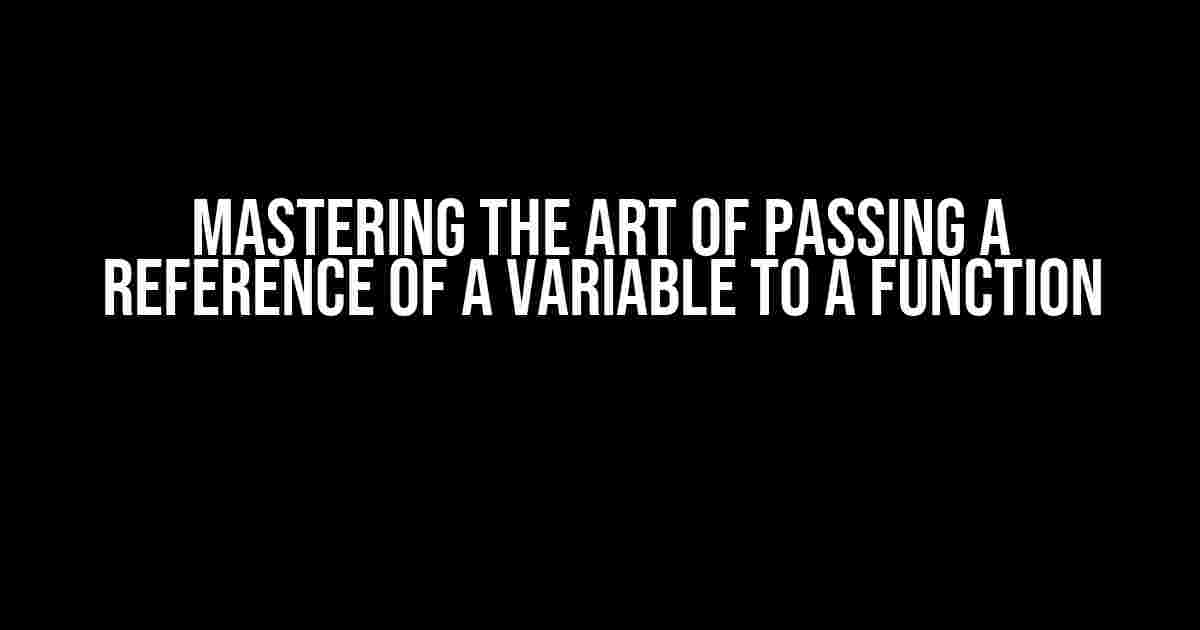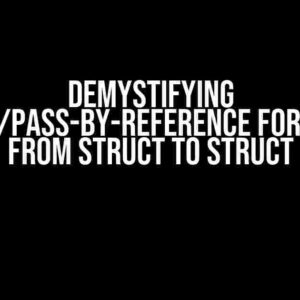Are you tired of dealing with the intricacies of variable passing in programming? Do you struggle to understand the difference between passing by value and passing by reference? Fear not, dear programmer, for we’re about to embark on a thrilling adventure to demystify the concept of passing a reference of a variable to a function. Buckle up, grab a snack, and let’s dive in!
What is Passing a Reference of a Variable to a Function?
In programming, when you call a function, you can pass variables as arguments to it. There are two ways to pass variables: by value and by reference. Passing by value creates a copy of the original variable, whereas passing by reference passes the actual variable itself. In this article, we’ll focus on the latter, which is often more efficient and powerful.
Why Pass by Reference?
So, why would you want to pass a reference of a variable to a function? Here are a few compelling reasons:
- Efficient memory usage: When you pass by value, a copy of the variable is created, which can be memory-intensive for large datasets. Passing by reference, on the other hand, shares the original memory address, reducing memory usage.
- Faster execution: Since no copy is created, passing by reference is generally faster than passing by value.
- Mutable variables: When you pass by reference, you can modify the original variable inside the function, which can be useful for changing the state of an object or array.
How to Pass a Reference of a Variable to a Function
Step 1: Declare the Variable
First, declare the variable you want to pass to the function. This can be any data type, including primitives, objects, arrays, or even functions.
let originalVariable = 10;
Step 2: Define the Function
Next, define a function that takes a reference to the variable as an argument. Note the use of the ampersand (&) symbol before the parameter name, which indicates that the variable is passed by reference.
function modifyVariable(&variable) {
// code to modify the variable goes here
}
Step 3: Call the Function
Now, call the function and pass the variable as an argument. Make sure to use the address-of operator (&) before the variable name to pass it by reference.
modifyVariable(&originalVariable);
Step 4: Modify the Variable (Optional)
If you want to modify the original variable inside the function, you can do so by assigning a new value to it. This modification will be reflected in the original variable outside the function.
function modifyVariable(&variable) {
variable = 20; // modifies the original variable
}
Best Practices and Considerations
When passing a reference of a variable to a function, keep the following best practices and considerations in mind:
- Avoid modifying the original variable unless absolutely necessary. This can lead to unexpected behavior and bugs.
- Use const correctness to ensure that the function doesn’t modify the original variable accidentally.
- Be mindful of scope and lifetime of the variable. If the function returns a reference to a local variable, it will be invalid after the function returns.
Examples and Use Cases
Now that we’ve covered the basics, let’s explore some practical examples and use cases for passing a reference of a variable to a function:
Swapping Variables
A classic example of passing by reference is swapping the values of two variables. Here’s how you can do it:
function swapVariables(&a, &b) {
let temp = a;
a = b;
b = temp;
}
let x = 10;
let y = 20;
swapVariables(&x, &y);
console.log(x); // outputs 20
console.log(y); // outputs 10
Modifying an Array
Another common use case is modifying an array inside a function. Here’s an example:
function modifyArray(&arr) {
arr.push(4);
arr.push(5);
}
let originalArray = [1, 2, 3];
modifyArray(&originalArray);
console.log(originalArray); // outputs [1, 2, 3, 4, 5]
Returning a Reference
Sometimes, you might want to return a reference to a variable from a function. Here’s how you can do it:
function getReference() {
let x = 10;
return &x;
}
let ref = getReference();
console.log(ref); // outputs 10
Common Pitfalls and Troubleshooting
Even with the best practices, you might encounter some common pitfalls when passing a reference of a variable to a function. Here are some troubleshooting tips:
- Check for scope and lifetime issues: Ensure that the variable is still in scope and has a valid lifetime when the function returns.
- Watch out for dangling references: Avoid returning a reference to a local variable, as it will be invalid after the function returns.
- Be cautious with const correctness: Ensure that the function doesn’t modify the original variable unless explicitly intended to do so.
Conclusion
And there you have it, folks! Passing a reference of a variable to a function is a powerful technique that can simplify your code and improve performance. By following the steps and best practices outlined in this article, you’ll be well on your way to mastering this essential programming concept. Remember to stay vigilant for common pitfalls and troubleshooting issues, and you’ll be writing efficient and effective code in no time.
| Keyword | Definition |
|---|---|
| Passing by value | Creates a copy of the original variable |
| Passing by reference | Passes the actual variable itself |
| Address-of operator (&) | Used to pass a variable by reference |
| Const correctness | Ensures that a function doesn’t modify the original variable accidentally |
Now, go forth and conquer the world of programming with your newfound knowledge of passing a reference of a variable to a function!
Frequently Asked Question
Get ready to grasp the concept of passing a reference of a variable to a function like a pro!
Q: What happens when I pass a variable to a function by reference?
When you pass a variable to a function by reference, you’re not actually passing the value of the variable, but rather a pointer to the memory location where the variable is stored. This means that any changes made to the variable within the function will affect the original variable outside the function.
Q: How do I pass a variable by reference in programming languages like C++ or Java?
In C++ and Java, you can pass a variable by reference using pointers (in C++) or references (in Java). For example, in C++, you would use the address-of operator (&) to pass the address of the variable, like `void myFunction(int &x)`. In Java, you would use the reference type, like `public void myMethod(String str)`, and then modify the original string object within the method.
Q: What’s the difference between passing by value and passing by reference?
When you pass by value, a copy of the original variable is created, and any changes made to the copy do not affect the original variable. Passing by reference, on the other hand, allows the function to directly modify the original variable. Think of it like sending a letter: passing by value is like sending a photocopy, while passing by reference is like sending the original letter itself!
Q: Are there any scenarios where passing by reference can be problematic?
Yes! Passing by reference can lead to unintended consequences if not used carefully. For instance, if a function modifies a variable that’s passed by reference, and that variable is used elsewhere in the program, it can cause unexpected behavior. Additionally, passing large objects by reference can be inefficient, as it involves copying the entire object.
Q: Can I pass a reference to a function in languages like Python or JavaScript?
In languages like Python and JavaScript, objects are passed by reference implicitly. When you pass an object to a function, you’re actually passing a reference to the object, which allows the function to modify the original object. However, for primitive types like numbers or strings, passing by value is the default behavior.





